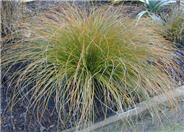
Common name:Orange Sedge
Botanical name:Carex testacea
The testacea variety is an evergreen perennial that reaches 2' tall bearing very narrow, coppery brown leaves splitting to hair-like threads at their tips, and continuing to grow to 4-8' in length. This plant should be grown in sun with little or no summer watering. During winter, foliage turns orange. If this grass is planted in shade, foliage stays green. Flowers are insignificant. Orange Sedge looks great in containers or spilling over near walkways or into water features.
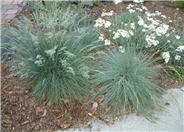
Common name:Blue Fescue, Blue Fescue Grass
Botanical name:Festuca glauca
This ground cover/grass will grow less than 1' tall and has small, blue-green, evergreen leaves that are very thin and hair-like. Flowers appear in the summer but are insignificant. This dependable ground cover prefers full sun in coastal areas and afternoon shade in warm inland areas. It needs well draining soil and is drought tolerant once it's established. Leaves may burn during the summer but trim in winter to keep it looking refreshed.
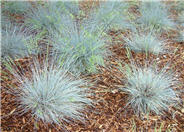
Common name:Siskyou Blue Fescue
Botanical name:Festuca 'Siskyou Blue'
Siskiyou Blue Fescue has beautiful blue grass blades to about 2' tall.
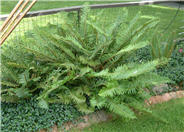
Common name:Western Sword Fern, Alaska Fern
Botanical name:Polystichum munitum
This Fern produces upright fronds, reaching 4'-5' tall in moist, cool forests in Northern California. This size is usually lower, especially without summer watering. It is great in containers or dry shade landscapes. This species is especially useful to give the illusion of lush, moist gardens where little water is actually being used. It should receive part shade to dense shade. -Monterey Bay Nursery

Common name:Silver Maple, Soft or White Maple
Botanical name:Acer saccharinum
This fast-growing, equally spreading tree can reach heights of 40-100'. Leaves of 3"-6" in width are five-lobed, with a light green top color and silvery color beneath. The fall color is a mixture of scarlet, orange and yellow. With an aggressive root system, this tree can be hard on sidewalks and sewers. It is, however, one of the best trees for poor soils where few other trees will grow.
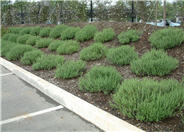
Common name:Trailing Germander
Botanical name:Teucrium X lucidrys
This mini-shrub with small, shiny, dark green leaves on woody stems can be sheared and shaped. The stems trail and rise to 24", with lovely, reddish purple flowers between the upper leaves. It can be used as a low hedge plant in herbal knot gardens. To encourage branching, it should be pruned in the spring. -Holland WIldflower Farm

Common name:Glossy Abelia
Botanical name:Abelia X grandiflora
Abelia X grandiflora is a semi-evergreen shrub of medium size. It has small, white, fragrant flowers that bloom from spring through the fall season. Bracts add a bronzy tint to the flowers. Abelia makes a good sheared hedge or screen. When unsheared, it is naturally arching.
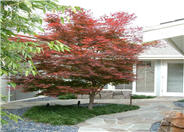
Common name:Bloodgood Japanese Maple
Botanical name:Acer palmatum 'Bloodgood'
'Bloodgood' slowly grows to 20'-25' high and 20' wide. Deciduous, toothed, lobed leaves are red in spring and summer, changing to scarlet in fall. This popular Japanese maple needs protection from drying winds and full sun in hot summer areas. It does well in dappled shade. It needs well draining, moist, acidic soil. This is a spectacular tree all 4 seasons.
Designer: Karen Marshall-FY/Homeowner-BY
Photographer: GardenSoft
Physical weed control, including mulching, or hand removal protects the watershed from harmful chemicals.
Attract, or buy beneficial insects such as ladybugs and lacewings to control pest outbreaks in your garden.